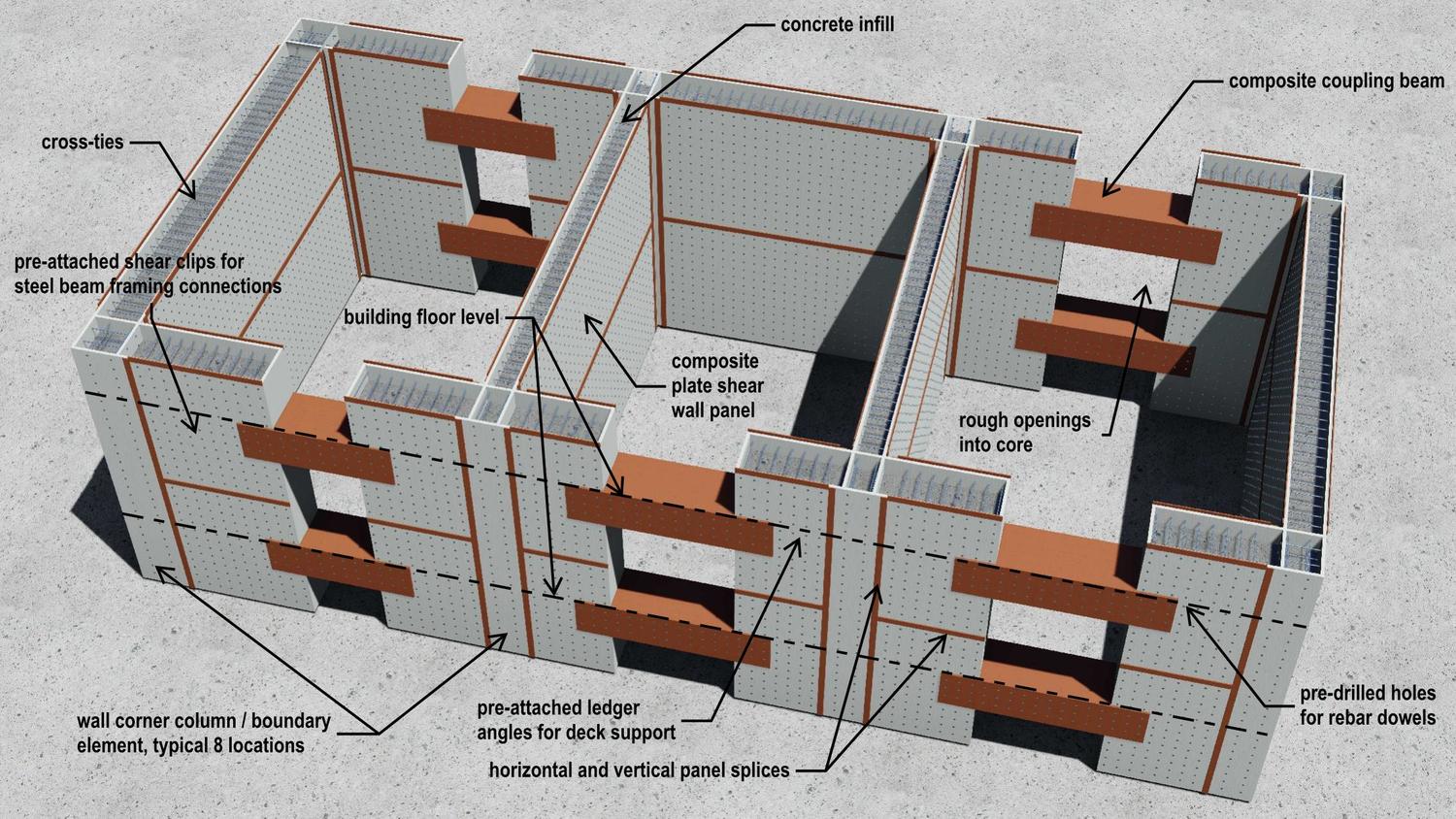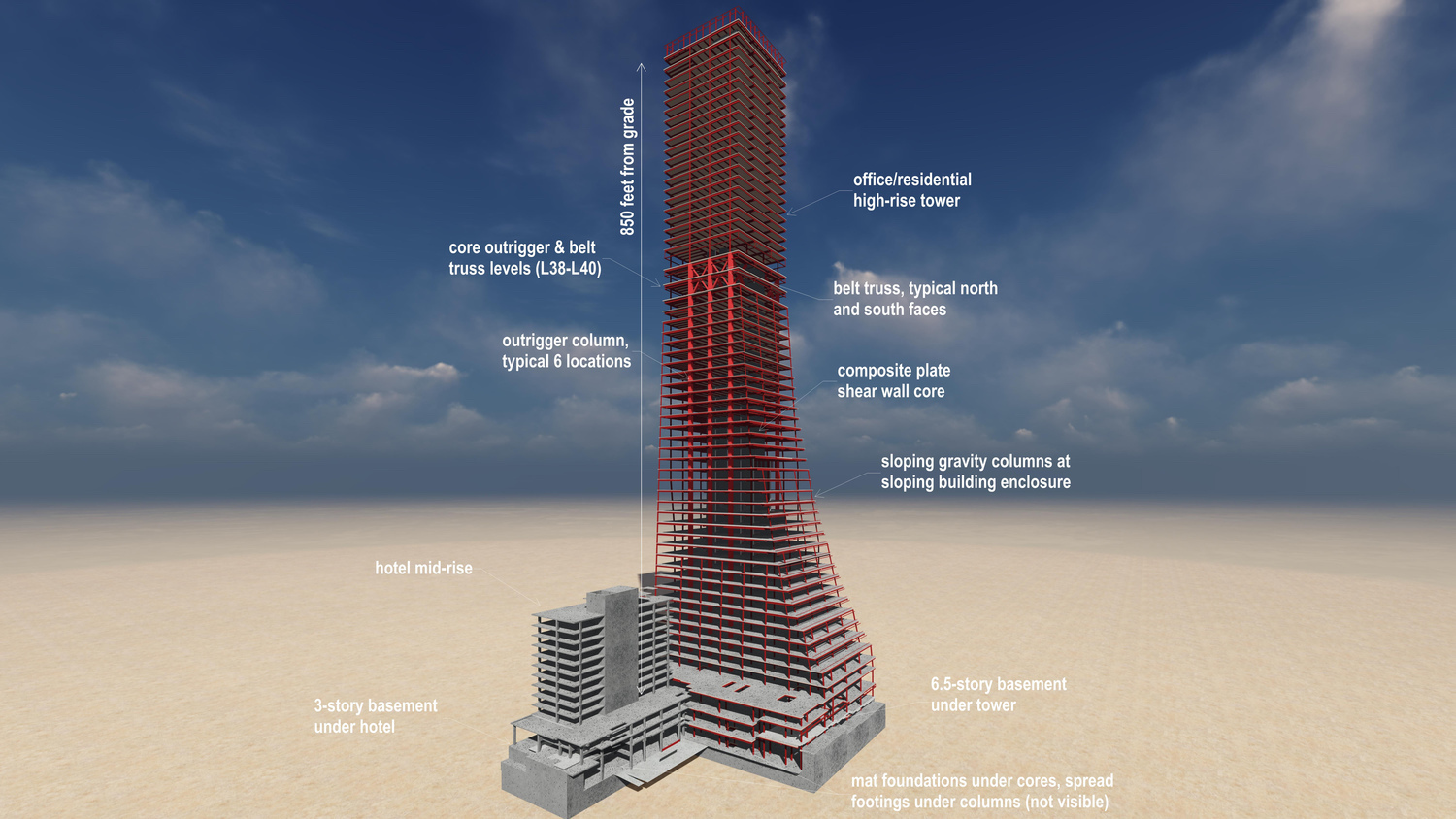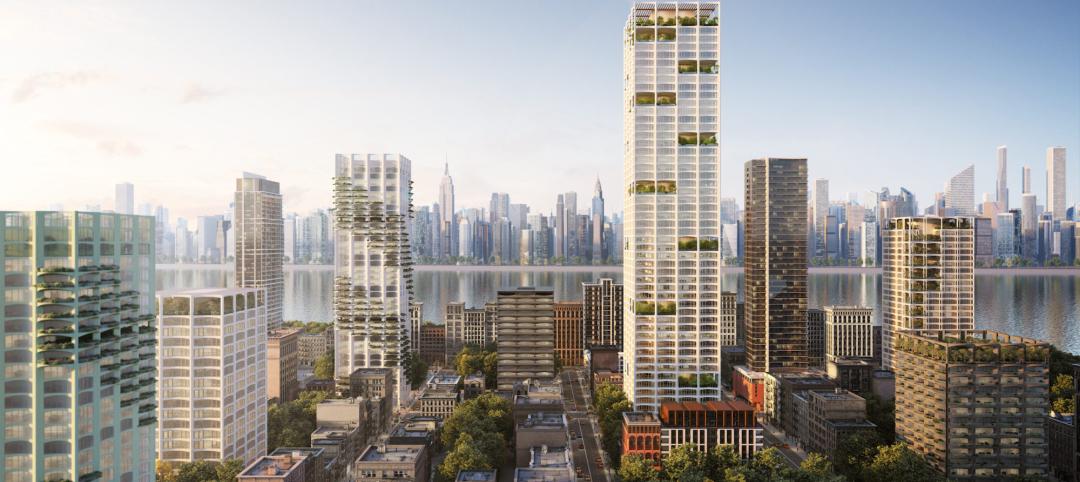Over the past 50 years, high-rise construction had gone through several approaches. In the 1960s, tall buildings were braced around their perimeters, but developers and tenants objected to obstructed views, which led to a shift toward steel cores. That method, however, proved uneconomical, and was replaced, in the 1980s, by structural systems with braces of large composite columns filled with concrete.
The diameters of those columns got in the way of elevators, bathrooms, and corridors, so in the 1990s cores were built with reinforced concrete, which are how most skyscrapers are constructed today.
But construction is still dictated by how fast the core gets built. Enter Speed Core, a steel-and-concrete composite core wall system that uses two steel plates connected by steel spacing ties with a cavity between the plates filled with high-strength concrete.
Magnusson Klemencic Associates (MKA), which spearheaded the development of this concept, is using Speed Core for Rainer Square, a 1.4 million-sf, 850-foot-tall, 58-story apartment and hotel building in Seattle.
 Source: Magnusson Klemencic Associates
Source: Magnusson Klemencic Associates
Through June, 40 stories were finished, and MKA expects construction to take 22 months, saving eight months from what it would have taken to build with a reinforced concrete core.
Ron Klemencic, PE, SE, Hon. AIA, Chairman and CEO, says his firm got the idea for Speed Core after it came across a technique developed in the United Kingdom that was used primarily for blast protection by the defense and nuclear industries.
MKA's R&D journey: A better way to build skyscrapers
In 2007, MKA engaged Purdue University, Klemencic’s alma mater, to research a new steel core system for high-rise buildings. The Charles Pankow Foundation funded the research.
It took three years to come up with a proof of concept for a composite sandwich panel, and another decade to find a client willing to try it on an actual construction project. Developer Wright Runstad & Company, a longtime MKA customer, allowed the firm to pursue this for Rainer Square. The team, which included architect NBBJ, spent six months on the design, which a panel assembled by the city of Seattle reviewed.
There are 240,000 rods used to connect the steel plates that are part of the panels. Purdue and the University of Buffalo are working on the next generation of core design, which Klemencic says might include smaller welds, thinner plates, and one-third fewer rods.
Klemencic says Speed Core aligns with MKA’s ambition to improve with every project. “With Speed Core, we’re living the dream,” he says.
MKA’s two-year-old foundation is funding research into performance-based wind engineering, reducing the carbon footprint in construction materials, and water resource management in buildings.
Related Stories
Multifamily Housing | Mar 1, 2023
Multifamily construction startup Cassette takes a different approach to modular building
Prefabricated modular design and construction have made notable inroads into such sectors as industrial, residential, hospitality and, more recently, office and healthcare. But Dafna Kaplan thinks that what’s held back the modular building industry from even greater market penetration has been suppliers’ insistence that they do everything: design, manufacture, logistics, land prep, assembly, even onsite construction. Kaplan is CEO and Founder of Cassette, a Los Angeles-based modular building startup.
AEC Innovators | Feb 28, 2023
Meet the 'urban miner' who is rethinking how we deconstruct and reuse buildings
New Horizon Urban Mining, a demolition firm in the Netherlands, has hitched its business model to construction materials recycling. It's plan: deconstruct buildings and infrastructure and sell the building products for reuse in new construction. New Horizon and its Founder Michel Baars have been named 2023 AEC Innovators by Building Design+Construction editors.
AEC Tech | Jan 27, 2023
Key takeaways from Autodesk University 2022
Autodesk laid out its long-term vision to drive digital collaboration through cloud-based solutions and emphasized the importance of connecting people, processes and data.
AEC Tech Innovation | Jan 24, 2023
ConTech investment weathered last year’s shaky economy
Investment in construction technology (ConTech) hit $5.38 billion last year (less than a 1% falloff compared to 2021) from 228 deals, according to CEMEX Ventures’ estimates. The firm announced its top 50 construction technology startups of 2023.
AEC Tech Innovation | Jan 14, 2023
CES recognizes a Dutch firm’s wearable technology for construction management
The firm’s TokenMe product offers construction managers a real-time crowd- and asset-tracking solution via low-power, location-aware radio and RFID tags and multiple sensors through which data are processed with cloud-based artificial intelligence.
Digital Twin | Nov 21, 2022
An inside look at the airport industry's plan to develop a digital twin guidebook
Zoë Fisher, AIA explores how design strategies are changing the way we deliver and design projects in the post-pandemic world.
Giants 400 | Nov 14, 2022
4 emerging trends from BD+C's 2022 Giants 400 Report
Regenerative design, cognitive health, and jobsite robotics highlight the top trends from the 519 design and construction firms that participated in BD+C's 2022 Giants 400 Report.
Contractors | Nov 14, 2022
U.S. construction firms lean on technology to manage growth and weather the pandemic
In 2021, Gilbane Building Company and Nextera Robotics partnered in a joint venture to develop an artificial intelligence platform utilizing a fleet of autonomous mobile robots. The platform, dubbed Didge, is designed to automate construction management, maximize reliability and safety, and minimize operational costs. This was just one of myriad examples over the past 18 months of contractor giants turning to construction technology (ConTech) to gather jobsite data, manage workers and equipment, and smooth the construction process.
Architects | Nov 10, 2022
What’s new at 173 architecture firms for 2022
More than 295 U.S. architecture and architecture-engineering (AE) firms participated in BD+C's 2022 Giants 400 survey. As part of the Giants survey process, participating firms are asked to describe their most impactful firm innovations and noteworthy company moves in the past 12 months. Here is a collection of the most compelling business and project innovations and business moves from the 2022 Architecture Giants.
40 Under 40 | Oct 19, 2022
Meet the 40 Under 40 class of 2022
Each year, the editors of Building Design+Construction honor 40 architects engineers, contractors, and real estate developers as BD+C 40 Under 40 awards winners. These AEC professionals are recognized for their career achievements, passion for the AEC profession, involvement with AEC industry organizations, and service to their communities.

















